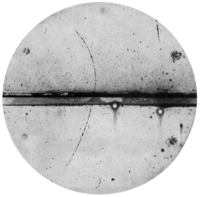
Photo from wikipedia
SuperKEKB is an electron-positron collider with asymmetric energies located at the High Energy Accelerator Research Organization (KEK) in Tsukuba, Japan. After more than five years of upgrading work on KEKB,… Click to show full abstract
SuperKEKB is an electron-positron collider with asymmetric energies located at the High Energy Accelerator Research Organization (KEK) in Tsukuba, Japan. After more than five years of upgrading work on KEKB, phase-1 commissioning commenced in February 2016 and ended in June of the same year. Following a 20-month shutdown for the installation of a particle detector, BELLE II, phase-2 commissioning commenced in March 2018 and ended in July of the same year. This paper describes one major issue faced by SuperKEKB: the electron cloud effect (ECE) in the positron ring, which was observed during phase-1 commissioning. In the high-beam-current region, electron clouds, i.e., the source of the ECE, existed in the beam pipes at drift spaces of the ring, which had antechambers and a titanium nitride (TiN) film coating as countermeasures against the ECE. Permanent magnets and solenoids used to generate magnetic fields in the beam direction were attached to the beam pipes as additional countermeasures before the next commissioning phase commenced. Consequently, during phase-2 commissioning, experiments showed that the threshold of the current linear density for exciting the ECE increased by a factor of at least 2 compared to that during phase-1 commissioning. While the countermeasures were strengthened, the effectiveness of the antechambers and TiN film coating of the real beam pipe was reevaluated. Through various simulations and dedicated experiments during phase-2 commissioning, the antechambers were found to be less effective than anticipated with regard to reducing the number of photoelectrons in the beam channel. In contrast, the TiN film coating had a low secondary electron yield, as expected.
Journal Title: Physical Review Accelerators and Beams
Year Published: 2019
Link to full text (if available)
Share on Social Media: Sign Up to like & get
recommendations!